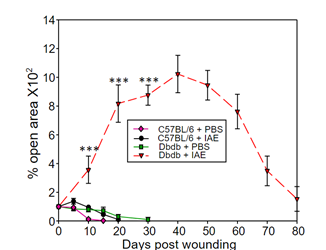Chronic Wound Mouse Model
Background
Normal wound healing is divided into several sequential phases that overlap during the healing period: homeostasis, inflammation, granulation tissue formation, and tissue remodeling. Chronic wounds develop as a result of defective regulation of one or more of the complex molecular and biological events involved in proper healing. Chronic wounds impact approximately 6.5 million people and costs 25 billion dollars per year in the US alone.
Brief Description
Prof. Manuela Martins-Green and colleagues from the University of California, Riverside have developed a mouse model for chronic wounds in db/db-/- diabetic mice. Wounds are considered chronic when the body is unable to properly facilitate every stage of the healing process due to Oxidative Stress (OS), which occurs when an imbalance of redox chemicals exists in the damaged tissues. To create the chronic wounds the mice were treated with inhibitors of antioxidant enzymes (IAE) at the time of wounding only. The wounds were then covered with tegaderm membranes and allowed to become chronic. Control wounds were treated with placebo.

Fig 1: Percent open wound area over time in wounds of C57BL/6 and db/db-/- mice.
Applications
- To test compounds that may reverse wound chronicity and eventually lead to healing of chronic wounds.
Patent Status
| Country | Type | Number | Dated | Case |
| United States Of America | Issued Patent | 10,376,489 | 08/13/2019 | 2013-216 |
Contact
- Grace Yee
- grace.yee@ucr.edu
- tel: View Phone Number.
Other Information
Keywords
chronic wounds, mouse model, oxidative stress, ulcers
